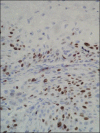Proliferating trichilemmal cyst: the value of ki67 immunostaining
- PMID: 24574687
- PMCID: PMC3927166
- DOI: 10.4103/0974-7753.125599
Proliferating trichilemmal cyst: the value of ki67 immunostaining
Abstract
Background: A proliferating trichilemmal cyst (PTC) is an uncommon, rapidly-reproducing cutaneous epithelial cyst, differentiating from the isthmic portion of the outer hair root sheath. It is usually described as a benign tumor, but malignant transformation has been reported and is then denominated as a malignant proliferating trichilemmal tumor. Ki67 immunostaining has been used as a methodology for the evaluation of tumor grade in other tumors, due to its distinctive reaction patterns which exclusively involve proliferating cells.
Objectives: (1) To report the incidence of cases of PTCs in a General Hospital during a 12 years period. (2) To determine the expression of ki67 using immunohistochemical staining. (3) To correlate ki67 reaction patterns with clinical prognosis.
Materials and methods: The dermatology department's files during a period of 12 years were reviewed; cases with a diagnosis of PTC were selected, and ki67 immunostaining was done when enough biological material was available.
Results: A total of 15 cases with a diagnosis of PTC were identified. In 12 cases, ki67 immunostaining was carried out. In 9 of the 12 cases, ki67 was observed in the basal cells of the cystic epithelium, one case was moderately positive in palisading epithelial cells; in the other two cases ki67 immunostaining was negative. Clinical follow-up was done and revealed that no patient had local recurrence in 5 years after surgical removal of PTC. We therefore consider this immunostaining technique is probably correlated with low recurrence potential.
Keywords: Hair follicle; ki67; pilar tumor; proliferating trichilemmal cyst.
Conflict of interest statement
Figures



Similar articles
-
Two Cases of Malignant Proliferating Trichilemmal Tumor (MPTT) and Review of Literature.R I Med J (2013). 2022 Feb 1;105(1):12-16. R I Med J (2013). 2022. PMID: 35081182 Review.
-
A Proliferating Trichilemmal Tumor at an Uncommon Site Treated With Radical Excision: A Case Report and Literature Review.Cureus. 2024 Jul 18;16(7):e64803. doi: 10.7759/cureus.64803. eCollection 2024 Jul. Cureus. 2024. PMID: 39156394 Free PMC article.
-
Morphological spectrum of pilar cysts.N Am J Med Sci. 2013 Feb;5(2):124-8. doi: 10.4103/1947-2714.107532. N Am J Med Sci. 2013. PMID: 23641374 Free PMC article.
-
The Proliferating and Malignant Proliferating Trichilemmal Cyst: An Anatomo-Clinical Study of Three Cases.Skin Appendage Disord. 2022 Mar;8(2):161-164. doi: 10.1159/000518354. Epub 2021 Oct 19. Skin Appendage Disord. 2022. PMID: 35419418 Free PMC article.
-
A malignant proliferating trichilemmal cyst arising on the elbow of a man: A case report and review of the literature.Medicine (Baltimore). 2023 Jun 23;102(25):e34035. doi: 10.1097/MD.0000000000034035. Medicine (Baltimore). 2023. PMID: 37352060 Free PMC article. Review.
Cited by
-
A Rare Cutaneous Adnexal Tumor: Malignant Proliferating Trichilemmal Tumor.Case Rep Med. 2015;2015:742920. doi: 10.1155/2015/742920. Epub 2015 May 4. Case Rep Med. 2015. PMID: 26064131 Free PMC article.
-
Malignant proliferating trichilemmal tumor of the scalp: report of 4 cases and a short review of the literature.Case Reports Plast Surg Hand Surg. 2022 May 23;9(1):158-164. doi: 10.1080/23320885.2022.2077208. eCollection 2022. Case Reports Plast Surg Hand Surg. 2022. PMID: 35634539 Free PMC article.
-
Extensive and ulcerated malignant proliferating trichilemmal (pilar) tumour, arising from multiple, large, degenerated trichilemmal (pilar) cysts.BMJ Case Rep. 2016 Feb 8;2016:bcr2015209785. doi: 10.1136/bcr-2015-209785. BMJ Case Rep. 2016. PMID: 26857582 Free PMC article.
-
Proliferating trichilemmal cyst with clinical, radiological, macroscopic, and microscopic correlation.An Bras Dermatol. 2019 Oct 17;94(4):452-454. doi: 10.1590/abd1806-4841.20198199. eCollection 2019. An Bras Dermatol. 2019. PMID: 31644620 Free PMC article.
-
A proliferating trichilemmal cyst in the perianal region: A case report.Int J Surg Case Rep. 2018;53:175-178. doi: 10.1016/j.ijscr.2018.09.049. Epub 2018 Oct 18. Int J Surg Case Rep. 2018. PMID: 30408740 Free PMC article.
References
-
- Sau P, Graham JH, Helwig EB. Proliferating epithelial cysts. Clinicopathological analysis of 96 cases. J Cutan Pathol. 1995;22:394–406. - PubMed
-
- Erdem H, Yildirim U, Uzunlar AK, Sahiner C, Ozcelik D, Toplu G. Posttraumatic giant proliferating trichilemmal cysts on the parietal region of the scalp. Indian J Dermatol Venereol Leprol. 2011;77:707–9. - PubMed
-
- Sethi S, Singh UR. Proliferating trichilemmal cyst: Report of two cases, one benign and the other malignant. J Dermatol. 2002;29:214–20. - PubMed
-
- Mathis ED, Honningford JB, Rodriguez HE, Wind KP, Connolly MM, Podbielski FJ. Malignant proliferating trichilemmal tumor. Am J Clin Oncol. 2001;24:351–3. - PubMed
LinkOut - more resources
Full Text Sources
Other Literature Sources

